


A5.1 City and Local Authorities can
play five major roles in alleviating the food insecurity of low-income urban
households
A5.2 Institutional
aspects
A5.3 Urban markets: responsibility for
providing infrastructure, facilities and services
A5.4 Methods for collecting
data
A5.5 Presentation of problems,
constraints and critical points, expected results and remedial
measures
A5.6 Problem analysis: an
approach
A5.7 Check list for identifying and
formulating a market infrastructure development project
A5.8 Making decisions about market
infrastructure interventions
A5.9 The external review
A5.10 Workshop agenda and report
format (phase 1 and 2)

A5.1 City and Local Authorities can
play five major roles in alleviating the food insecurity of low-income urban
households
Promote supportive attitudes and policies towards food
producers, processors, traders, shopkeepers, street vendors, transporters and
consumers
This requires:
- the awareness of all policy-makers to the needs of those involved in food
supply and distribution activities;
- the understanding by all decision-makers of how to improve the performance
of food supply and distribution systems;
- regular interactions with producers, transporters, traders, shopkeepers,
street vendors and consumers; the promotion of their associations and their
involvement in policy formulation and implementation;
- the strengthening and encouragement of representation of private associations
on planning committees and in policy implementation;
- the dissemination of policy goals, objectives and related information among
everyone involved in food supply and distribution activities;
- that your institution clearly states and pursues its mission to serve the
consumers, traders, shopkeepers, street vendors, transporters and producers
and adopts an open, communicative and efficient behaviour.
Promote private investment
The development of food supply and distribution systems
requires augmenting the investment in food production, marketing and processing.
This may be beyond the ability of the public sector to afford.
For private investment to emerge, there is the need for an
economic and political environment conducive to private sector risk-taking
accompanied by credible assurances by the state that the "rules of the game"
will be honoured.
You can stimulate private investments by:
- promoting rules governing public and private sector responsibilities and
interventions in food supply and distribution activities;
- ensuring that norms, licensing, procedures and standards are in line with
investors’ expectations and capacity;
- adequately enforcing laws and regulations, particularly those concerning
contracts;
- providing basic food production, market, transport and processing infrastructure,
facilities and services;
- ensuring adequate management of utilities companies;
- ensuring active, efficient land and real estate markets as well as land
tenure security.
Intervene in food supply and distribution
Planning
- Forecast needs for the city food and water and production potential over
the next ten years;
- identify poor urban households and map their location;
- prepare plans governing land use and occupancy;
- provide suitable public land, land-tenure security, safe water, etc. for
urban and periurban agriculture;
- prepare rural-urban and intra-urban transport development plans;
- design urban food market and processing infrastructure plans, etc.
Information
- Provide food transporters, traders, shopkeepers, street food vendors, processors
and consumers with basic information about food hygiene, health and nutrition
together with their rights and obligations;
- inform producers on proper use of agricultural inputs and chemicals, safe
solid waste and/or composting facilities, etc.
Infrastructure, facilities and services
- Define present and future needs for specific market and slaughterhouse
infrastructure, facilities and services, with respect to what (type), where
(location) and how (standards), taking into account the ecological conditions
of the city;
- define land allocation modalities;
- successfully design, locate, construct and manage urban markets and slaughterhouses;
- maintain and upgrade public infrastructure including water, toilets, drainage
and lighting;
- suitably dispose of solid and liquid waste;
- provide specific training to producers, traders, shopkeepers, etc.;
- levy municipal taxes and market fees;
- provide public transport to and from urban markets and slaughterhouses,
etc.
Regulations
- Regulate public land occupancy and use;
- license and control food production, processing and marketing activities;
- protect consumer through enforcement of food quality standards and food
retail outlet hygiene including street food and restaurants;
- apply legislation and regulations for meat inspection;
- enforce hygiene and health standards in food processing and sale outlets;
- manage traffic including parking, signals, routing and restrictions on
vehicle movement;
- control pollution and invoke standards for industrial and vehicle effluents/emissions
and noise control;
- enforce legislation on water quality control for food production and processing,
etc.
Coordinate public interventions and private
initiatives
Conflicts in the implementation, by different institutions and
NGOs, of their programmes limit the impact of development initiatives. Effective
coordination is required to avoid this condition. You are in the best position
to coordinate the area under your jurisdiction.
You need to:
- actively seek legal reforms that clarify the role of various public agencies;
- identify institutional and departmental responsibilities concerning food
supply and distribution systems;
- ensure, through training, motivation and monitoring, that personnel are
technically equipped to meet the growing demand for efficiency and accountability.
Intermediate between central government and the private
food sector
You can frame interinstitutional dialogue by:
- ensuring that the needs of food producers, processors, transporters, traders,
shopkeepers and consumers are voiced within central government;
- complementing efforts by farmers’ associations, NGOs and local authorities
in rural and periurban areas to lobby the central government. This mediation
can prioritize programmes and projects that will reduce production constraints
and strengthen rural-urban linkages (e.g. improved road, food assembly and
transport facilities, provide market information and marketing extension assistance).
(For details, see Argenti, 2000).
A5.2 Institutional
aspects
|
A.5.2.1: The Interinstitutional Steering Committee
(ISC)
The ISC will comprise representatives of the major local and central,
and public and private institutions directly interested in the study:
- the Municipal Authority of the city affected;
- the ministry in charge of the municipalities;
- the Ministry for Agriculture;
- the Ministry for Trade;
- the Ministry for Planning;
- the Ministry for Health/nutrition;
- the Chambers of Commerce and Agriculture;
- occupational associations (e.g. traders, transporters, food producers
and consumers);
- the universities and research institutes.
The ISC, preferably chaired by the mayor of the city concerned, shall:
- supervise and support the team’s research activities;
- ensure the effective cooperation of the national institutions implicated;
- facilitate team members’ access to all necessary data;
- periodically check the progress and assess the results of the team’s
work;
- ensure the effective deployment of interinstitutional study groups;
- promote the formulation of sectoral policies and programmes based
on the case study findings, and their adoption by their respective institution.
|
|
A.5.2.2: The Institutional Framework
Several partners are usually involved in programme implementation, e.g.
government bodies, local authorities, chambers of commerce, private associations,
NGOs and national financial institutions.
Each element of the action plan (subprogrammes, sets of remedial measures
and, even, specific measures) is often implemented under the responsibility
of a specific institution (the lead institution), but the work per se
is entrusted to several institutions which will be identified and their
respective responsibilities described with respect to:
1) the implementation of each programme element:
- define the roles and responsibilities of the partner institutions
to ensure efficient implementation and management;
- determine the degree to which management has been decentralized
in favour of local authorities and how active a role the players (consumers,
traders and service providers) have in FSDS management;
- determine, in particular, the level of technical expertise and
experience required of the institution to ensure satisfactory implementation
of each specific measure;
- identify the external technical assistance requirements to cover
any possible deficiencies.
2) decision-making capacity:
- measure the urban institutions’ influence on the scenario
as a whole, on the strategy tools and on funding;
- assess the degree of freedom to obtain internal and external funding,
and whether municipal borrowing is authorized and practicable;
- assess the determination to solve the problems.
The description of the institutional framework should include an analysis
of the structure, the staff and the partner organizations’ and funding
agencies’ management capacity, and an assessment of their strengths
and weaknesses.
Source: Willahert, 1998.
|
A5.3 Urban markets: responsibility for
providing infrastructure, facilities and services
|
Infrastructure, Facilities and Services
|
Characteristics and Form of Provision
|
Provider and Responsibilities
|
|
Basic trading infrastructure located in major business
districts: market stalls, shops and warehouses.
|
Feasible to charge economic user fees because of private good
characteristics. Therefore commercial provision (by private or public-private
mix) is possible.
|
Planning and design: city and local authorities (CLAs).
Investment: mix of CLAs and private capital (including prefinance by traders).
Management: autonomous, arms-length agency with clear commercial mandate or
private.
|
|
Basic trading infrastructure located in poor suburbs/slums:
market stalls and shops.
|
Private investment in open markets may be inadequate by
possible limited returns. Charging economic user-fees is feasible but exclusion
of non payers may have wider health and environmental effects. Possibility of
mixed provision. Private food shops and sales from homes need to be
encouraged.
|
Planning and design: CLAs. Investment: mix of CLA, community
and trader associations and community labour. Management: community or trader
associations.
|
|
Cold storage facilities, slaughterhouses, on-site processing
plants and transport.
|
Commercial provision. Those provided by governments tend to
suffer from poor management and maintenance.
|
Planning guidelines and regulation: CLAs. Design, investment
and management: private.
|
|
Parking space and child daycare facilities.
|
Charging economic user-fees is feasible but exclusion of non
payers may have wider social and environmental effects.
|
Planning, design and investment in infrastructure: CLAs
(private only in major business districts). Management: private.
|
|
Roads, public drains and sanitation facilities.
|
Difficult to exclude nonpayers and negative effects of
non-provision on others. Public provision necessary.
|
Planning and design: CLAs and Department of Urban Planning.
Investment: central government (Ministry of Finance).
|
|
Regulations and policing including food import controls,
quality control, health and food safety standards.
|
Typical example of public good.
|
Drafting bylaws and legislative instruments on standards:
CLAs, food standards agency. Gazette regulations: central government
(legislature). Enforcement: police and judiciary.
|
A5.4 Methods for collecting
data
A5.4.1 Bibliographical Research
|
Bibliographical research entails:
- identification of the sources of data and information on the issues
national, regional, sectoral and municipal development plans; official
national or sectoral policy documents; official statistics; studies,
publications and articles; development project reports; international,
regional and national seminar proceedings; correspondence and minutes
of meetings;
- a critical collection of bibliographical data whose usefulness and
validity must be evaluated in relation to the points included in the
TOR;
- presentation of the bibliographical data: useful information must
be incorporated into the table proposed in the TOR. This would show:
- available data;
- the various points of view on some aspects of the issues and the
measures to be envisaged;
- the additional data required to proceed with the case study;
- the research areas to be examined in further detail.
Given the interdisciplinary nature of the study, sources will have to be
found in the fields that are potentially relevant to the study. Therefore,
the bibliographic research will be pluridisciplinary.
|
A5.4.2 Interviews
|
Interviews will provide the views of the groups of players involved in
FSDSs, ongoing and planned measures and research. To gain maximum benefit
from an interview:
- have adequate information about the person to be interviewed and
about his/her institution;
- define the aim of the interview;
- prepare a list of key questions and topics for discussion;
- clearly explain the reasons for the interview (e.g. the objective
of the FSDS study, the interview and the importance of the information
the interviewer wishes to obtain from the interviewee);
- ensure that the information obtained is precisely understood;
- obtain critical information on available technical documentation
and request a copy;
- prepare a brief report of the interview and indicate the action to
be taken. Give the team coordinator a copy of the report.
|
A5.4.3 Direct Observations
|
Direct observation during field visits provides qualitative and quantitative
data on legal and illegal taxes on markets and at roadblocks, selling
prices of food, transport costs, physical and operational conditions in
markets, goods traffic, food presentation and hygiene.
A field visit requires organizational effort, but modest financial resources.
To make the most of this type of visit:
- ensure that the site, the weather (seasons, months, weeks, days and
time) and the conditions are right for the purpose of the visit (a sunny
day will not be appropriate to assess a market’s propensity to
flood!);
- clearly define the information required;
- prepare a list of questions in the event
- of interviews;
- prepare a list of the tasks to be accomplished.
|
A5.4.4 The Mini-Survey
|
Mini-surveys may be necessary to collect important quantitative or qualitative
data that are not already available or out of date.
As surveys require considerable organization, human and financial effort,
it is important to:
- ensure that the data sought are not already available;
- carefully define the objectives, the sample and all other details
of the survey;
- limit as much as possible the information to be collected. Avoid
the temptation to conduct excessively detailed surveys;
- ensure that the place, weather (season, month, week, day and, even,
time) and conditions are right for the survey;
- carefully prepare the questionnaires and test them before launching
the survey;
- ensure that the work plan allows sufficient time to carry out the
survey and analyse the data;
- ensure that human and financial resources are ready to carry out
the survey, process and analyse the data.
|
A5.5 Presentation of problems,
constraints and critical points, expected results and remedial
measures
A5.5.1 Presentation of Problems, Constraints and Critical
Points
|
Problem
|
Brief description of the problem. Has it been perceived by the
various interest groups?
Does it interest the urban, periurban or rural
areas?
|
|
Context
|
Brief description of the specific context.
|
|
Causes
|
Indicate the direct and indirect causes (factors responsible)
of the observed phenomenon.
State the points of the view of the different interest
groups.
|
|
Consequences:
|
Immediate State the immediate direct and indirect consequences
(responsibilities). State the points of view of the interest groups. Do they
pertain to the urban, periurban or rural areas? Medium and long term State the main medium and long term consequences of taking no
remedial action (status quo scenario). State the points of view of the interest
groups. Do they affect the urban, periurban or rural areas?
|
|
Solutions
|
Indicate the various solutions (results) expected. Have they
been put forward by the interest groups? Do they concern the urban, periurban or
rural areas?
|
A5.5.2 Presentation of Remedial Measures
|
Measure
|
Briefly describe the proposed measure.
|
|
Result
|
Briefly describe the expected result.
|
|
Problem
|
Briefly describe the problem to be solved.
|
|
Strategy
|
Identify the relevant strategy.
|
|
Space
|
State whether the measure concerns urban, periurban or rural
space, or a combination ofall three.
|
|
Time
|
State the time (in months) it will take to obtain interim or
final results.
|
|
Beneficiaries
|
State who the direct and indirect beneficiaries will
be.
|
|
Instit. respons.
|
Give the names of the lead institution and the partner
institutions.
|
|
Alternatives
|
Are there alternative ways to resolve the problem: e.g. public
or private and centralized ordecentralized?
|
A5.5.3 Remedial Measures: Selection Criteria
|
Benefits
|
- What are the direct and indirect benefits of the proposed measure?
- Will the proposed measure solve several problems simultaneously?
- Is long term viability assured?
|
|
Consequences
|
What will be the major negative consequences of the measure in
the short, medium and long term? Will they be acceptable? By whom?
|
|
Realism
|
Is the measure realistic from the following viewpoints:
- political: how politically acceptable will the measure be in the
short, medium and long term?
- strategic: is the proposed measure in line with central and/or local
government strategy and with the strategy defined to attain the desired
scenario?
- institutional: is the implementing institution capable of implementing
and managing the measure?
- financial: will the proposed measure be covered by available funds
bearing in mind the need to implement other measures in the same sector?
If not, what steps are required to ensure that the proposed measure
can be finally sustained?
|
|
Efficiency
|
- Do the expected economic benefits justify the use of the funds?
- How more efficient than alternative measures is the proposed measure?
|
|
Other considerations
|
- To what extent is the proposed measure a pillar of the strategy?
- Do the project results depend on other projects being implemented
in other sectors (a typical example is the building of an access road
which is independent of FSDS planning). Is this external element a determining
factor?
- Are the specifications adequate? Will feasibility studies be necessary
in order to include the measure in the programme?
- If this is a regulatory measure, has it been evaluated by the beneficiaries?
- Must general policy considerations or matters concerning the security
of person/goods be considered?
|
A5.5.4 Presentation of Expected Results
|
Problem
|
Brief description of anticipated result.
|
|
Complexity
|
Explain why the anticipated result can be obtained in a
relatively easier or more complex way than other possible results.
|
|
Direct benefits
|
Will the direct benefits be sustainable over time? Will
subsequent remedial action be necessary?
|
|
Indirect benefits
|
State whether the anticipated solution will solve, even
partially, another problem.
|
|
Consequences
|
State the main consequences likely to ensue from the
anticipated result in the medium term and long term.
|
|
Complementary
|
State whether the anticipated solution will require
complementary measures.
|
A5.6 Problem analysis: an
approach
A5.6.1 Developing a research path
A table must be prepared setting out the city’s problems.
The table must then be converted into an operational research path with the aid
of maps of the city and its surrounding area. The plan below shows how develop a
research path.
|
Urban food demand
|
- Food consumed;
- average consumption per inhabitant.
|
- Changes in and factors determining consumption and purchasing models;
- main consumption and preparation practices
- main purchasing practices;
- projection of urban food demand.
|
|
Characteristics of urban areas
|
- Urban expansion patterns;
- urban population dynamics;
- social segregation phenomena;
- population distribution by economic levels (location of poverty levels).
|
- Retrospective analysis (covering 15-20 years);
- projection of urban expansion to 10 years;
- projection of the urban population;
- commercial structures and urban growth;
- conflicts over land use;
- urban land management policies;
- institutions and policies relating to urban food security.
|
|
Location of food arrival points in urban and periurban
areas
|
- Main markets;
- roads into the city;
- rural/urban transport facilities;
- food types, flows and quantities.
|
- Areas of food origin or production;
- important pipelines
- players (e.g. wholesalers, middlemen and transporters);
- public and private commercial services (e.g. information and credit);
- service management practices.
|
|
Location of urban distribution
|
- Intra-urban markets and marketing structures;
- location and quantification of food flows to urban areas;
- intra-urban transport.
|
- Traders, transporters, etc.
- market management practices;
- product processing;
- forms of urban distribution;
- rules governing trade and related services;
- marketing channels, marketing costs and margins;
- employment generation
- informal activities.
|
|
Ongoing or planned policies, programmes
|
- General economic policies covering FSDSs; FSDSs;
- urban food security programme;
- administrative decentralization;
- on-going and planned programmes of FSDS improvement measures.
|
- Direct and indirect effects of general and sectoral policies; institutional
responsibilities at territorial and sectoral levels;
- conflicts and synergies between administrative levels, and between
sectoral and territorial administrations.
|
A5.6.2 Determining the Relative Importance of the Problems:
an ExampleThe case study of city X revealed the following
problems:
- entry to market restricted;
- shortage of market structures;
- regional transport network inadequate;
- lack of services: urban road network, hygiene standards, market management.
All these problems have a negative effect on the efficiency of
distribution and cause the purchase prices of all foods to rise. But are they
all equally important? What order of priority can be assigned to them?
|
Problem
|
Function concerned
|
Level concerned
|
Functional relationships
|
|
1
|
traders
|
=
|
4, 2
|
|
2
|
markets
|
urban
|
3, 4, 1
|
|
3
|
transport
|
extraurban
|
2
|
|
4
|
services management
|
urban
|
1, 2
|
This simple analytical table shows that:
- the problems concern different levels;
- problem 1 has to do with resources;
- problems 2 and 3 concern structural aspects;
- problem 4 has to do with management;
- problems 1 and 4 are related: market management has a bearing on certain
aspects of the way the market is run;
- problems 2 and 3 also have a functional relationship as the urban network
is part of the national network in terms of transport and food distribution;
- problems 2 and 3 are linked functionally, but concern different geographical
levels;
- problems 2, 4 and 1 (in part) are related in geographical (city level)
and functional terms (urban services affect market operation and the efficiency
of urban transport).
This analytical table suggests that:
- solving a services management problem could have significant effects on
a number of FSDS aspects, with relatively limited investment and rapid results;
- building new markets should go hand in hand with improving the national
road network. This would require a significant investment effort and a medium
to long time frame.
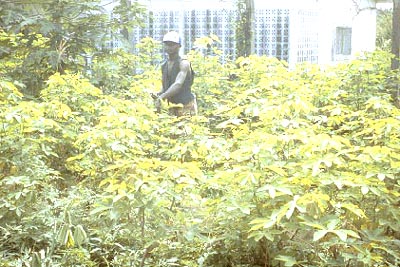
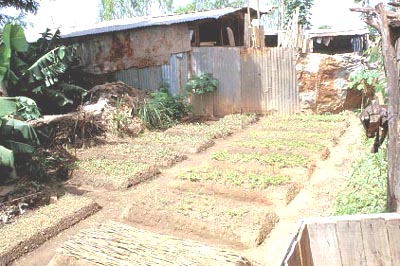
A5.7 Check list for identifying and
formulating a market infrastructure development project
Initial background information
- Has a basic list of wholesale and retail markets been drawn-up and their
locations mapped?
- What are the existing wholesale and retail market channels for fresh produce
and other foodstuffs?
- Where are the products sold (in wholesale and retail markets, shops, itinerant
markets, supermarkets, through institutional buyers or through direct sales
to consumers). What is the estimated throughput and the role of these different
channels?
- Background information on existing traders and transporters, their type,
location and scale of operation.
- Have official statistics (including projections over the next ten years)
on agricultural production, urban consumption and background information on
agricultural marketing been collected?
- Estimated existing and projected throughput of the new market facilities.
For simple markets, this can be based on a survey of just the overall quantities
of produce traded. For assembly and wholesale markets a more comprehensive
food balance approach is needed.
- Have arrangements been made to undertake preliminary surveys of existing
markets?
- Legal and financial data relating to the local authority’s marketing
department, a market authority or private company.
- Details of the local planning factors, including the compatibility of the
market with surrounding land uses.
- Details of any relevant background studies on food products and/or marketing,
including existing and planned wholesale and retail trade developments.
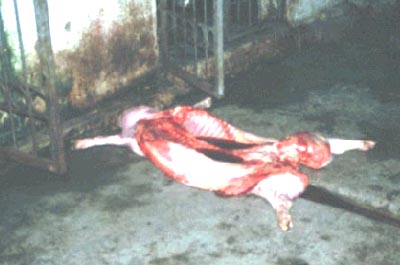
Factors to be considered in identifying the investment
project
The policy context
- Has the basic purpose and funtion of the project been identified?
- How does this fit in with other policies? Are there possible conflicts?
- What are the priorities in the event of conflict with other policies?
- What is its relationship to and impact with other policies?
- Have the development options been evaluated and ranked so a clear solution
is identified?
- What are the main elements or functions to be included in the project?
- What is the demand for the project and its relationship to existing facilities?
Main operational factors
- Who are the likely stakeholders and how will they be involved in the planning
stage?
- What are the available financial resources and expertise? What additional
financial resources and expertise are likely to be required?
- What are the activities to be incorporated in the project?
- Are there specific environmental requirements?
- Is there any likelihood of change in the future and what flexibility is
required?
- What will be the management structure (public v. private)?
- What outside services (e.g. banking, cleaning, caterers, post office) are
required?
Formulating the market project
General factors in Market Master Plan
preparation
- What are the main desired features of the site’s location?
- What planning and other constraints are likely to effect the projects?
- What traffic and environmental implications are there likely to be? What
are the existing and expected traffic movement patterns (number of vehicles
and proportion of different types of vehicles).
Evaluating the project
- Has an assessment been made of the potential benefits of the project in
meeting its objectives?
- Have the legal, environmental, urbanistic and social impacts of the project
been evaluated?
A5.8 Making decisions about market
infrastructure interventions
A5.8.1 Criteria for Screening and Prioritizing Market
Improvements
Among wholesale and retail markets, there may be a number of
potential candidates for improvements. At the identification stage it will be
necessary to prioritize these so that a realistic improvement programme can be
drawn-up. The factors used in the selection criteria and the prioritization
process can be given equal weighting, can be ranked (so that a particular factor
which is of importance to the development programme can be emphasised) or can be
used in a sequential manner to provide a decision tree.
Most Important Selection Criteria
1. The markets are presently in an unimproved state;
2. they have a special function, such as an assembly market, an urban producer
market, or are serving a large rural or urban catchment area;
3. they trade in fresh produce;
4. the sites are on land already owned by local government, a market body
authority, or the local community;
5. they can be subject to a formal agreement where the development actions
would be implemented through market committees established with the agreement
and participation of the traders;
6. there is a willingness on the part of the market traders to improve the
efficiency of the present market operations and to accept higher fee or rental
charges as a condition of improvements being made;
7. assurances have been obtained that adequate revenues from the improved
markets could be generated to cover all operational and maintenance costs
and provide funds for further market improvements; and
8. the private sector is willing to take responsibility for improving individual
sheds and stalls, and the project limits its activities to investment in the
upgrading of "common" basic infrastructure, such as:
- site preparation, fencing, parking areas, internal road works and covered
sheds and open sales areas;
- a simple surface/formwater drainage system, sanitary accomodation and
a water supply; and
- garbage collection points, collection carts and shade tree planting.
Ranking of Market ProposalsGenerally, market improvements are only likely to be viable if
the levels of investment are relatively modest. The incremental benefits of
undertaking the market improvements should provide sufficient revenues to cover
all operating costs, including putting aside a fund for future market expansion.
Revenues are often likely to be sufficient to cover repayment of capital and
interest even assuming a long repayment period and a grace period before
repayment. The returns are very sensitive to the daily charges. Thus, after
meeting the selection criteria outlined above, the shortlist of proposals should
be evaluated and ranked according to:
1. whether they make a significant contribution (in terms of volume
turnover) to the trading of fresh produce;
2. their importance in the overall market system, with priority given to
unimproved major markets;
3. whether it is possible to use an improved existing market site. A new
market site should only need to be considered if it is necessary to replace
an existing congested site or if there is an urgent need for expansion because
of population growth; and
4. the local development planning framework:
- whether improvements can be linked to other related programmes, such
as parallel marketing activities, the rehabilitation of rural-urban roads
or small-scale civil works (drainage and flood control works, culverts and
bridges, in areas adjacent to marketing access roads) that would allow the
market to function more effectively;
- there is local community willingness to make an undertaking to maintain
the facility once it has been improved;
- there exists compatibility of the selected markets with areas targeted
under needsbased policies (such as high density areas deficient in services);
- there exists complementarity with lending, donor and NGO programmes;
- whether alternative funding sources are not available; and
- whether there is the possibility that a programme of works could be packaged
together to form viable construction contracts for a series of market improvements.
A5.8.2 Basic Questions for Developing a Justification for
Market Infrastructure
- Has consideration been given to whether the development is really
necessary?
- is it clear why there is a need for a new market?
- have alternatives been considered, such as improving existing markets
by rehabilitating or expanding?
- has thought been given to the consequences of a new market on the
environment?
- have the implications for traffic and parking space been considered?
- is there a consensus on the financial and economic rationale for
the project? Is it agreed that it should be run on a profitmaking or,
at least, on a cost-recovery basis, i.e. be "economically sustainable"?
- what are the traders’, transporters’ and consumers’
reactions to the proposals?
- is there a possibility or agreement for increasing market user charges?
For larger markets, such as urban wholesale and retail markets, further
factors may need to be considered:
- has thought been given to all the accompanying measures which may
be required to protect the economic interest of those traders to be
relocated to a new market site?
- why should traders want to move to a new market?
- will services (e.g. banks) also be willing to move to the new market?
- has an estimate been made of how much more traders will have to pay
to distribute food from the new market back into town?
- has the involvement of traders and transporters in the operation
of the market and its management been agreed?
Finally, are the next steps on how to proceed with the market development
clear?
Source: Tracey-White, 2000.
|
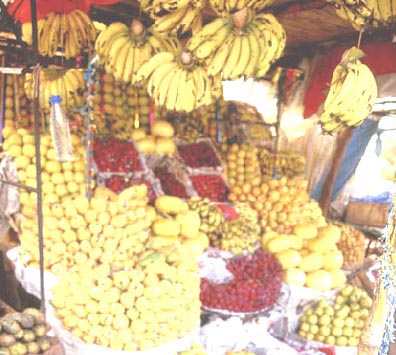
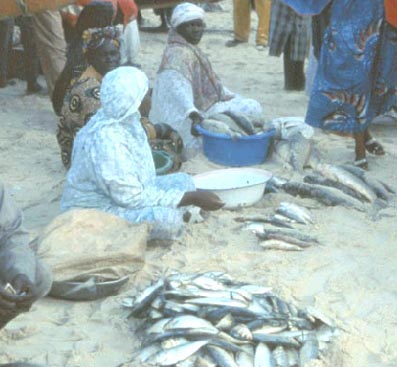
A5.9 The external review
A5.9.1 The Participatory Approach
|
The urban communities (e.g. neighbourhoods and sectors) will
normally have been consulted during the diagnostic process to get their points
of view on local problems and possible solutions. However, between this and the
programming stage, some solutions will have gone through a sifting process. In
the meantime, local proposals might have undergone radical changes. It will
therefore be essential to start discussions during the development programme
preparation stage in order to obtain a consensus. Indeed, FSDSs are a very
sensitive issue as they have a direct bearing on households’ economic life
and urban communities’ social life. In some cases, the team will have to
include an urban sociologist and/or persons capable of acting as intermediaries
between the team and the urban communities. Discussions will often have to
include CLAs decision-makers.
|
A5.9.2 Suggestions for Maximum Benefit from a Final
Review
|
At the organizing stage:
- test the all papers in advance so as to ensure that their content
is clear and pertinent;
- carefully select the participants in the discussion. Ensure that
all interest groups (traders, transporters, consumers, farmers, extension
workers and civil servants in the ministries and local authorities)
are represented;
- ensure that the presence of decision-makers or senior civil servants
does not inhibit participation in the discussions;
- restrict the number of participants so as to get the most out of
the discussions.
During the meeting:
- distribute any additional technical papers only at the end of the
meeting so as not to distract participants attention.
- explain clearly the aims of the discussion session;
- give the review the feeling of a "working", not an "official", session
and limit ceremony as much as possible so as to make the most of the
time available for technical discussions.
Minutes of the meeting:
- appoint a rapporteur to draw up a brief summary of the discussions,
criticisms and additional proposals. The items on which agreement is
or is not reached should be identified;
- distribute the minutes of the discussions to the participants;
- review the case study (especially its conclusions and recommendations)
as well as all proposals for action in light of the participants’
discussions, criticisms and recommendations. Prepare a final version
for official distribution.
|
A5.9.3 Workshop Participants
|
Local Government:
- Mayor, Deputy Mayor and City Executives;
- Senior officials of municipalities and other concerned authorities
(urban planning, infrastructure development, health, transport, etc.);
- municipal police and transport police.
Central Government:
- the Ministry of Agriculture (sections in charge of food production
development in rural, periurban and urban areas; food product marketing,
food quality control; agricultural extension service; etc.);
- the Ministry of Trade (section in charge of internal commerce);
- Ministry of Internal Affairs (sections dealing with municipalities
and police);
- Ministry of Urbanization (sections dealing with urban infrastructure
and of issues related to urban food marketing);
- Ministry of Health (sections concerned with food quality, safety
and environmental issues);
- authorities responsible for transport infrastructure and facilities;
- universities and research institutions;
- other concerned institutions;
- agricultural development banks.
Private sector:
Associations of food producers, transporters and processors, food traders,
shopkeepers, street vendors, consumers, Chambers of Commerce and Agriculture,
NGOs, etc.
Donors and development agencies:
UNDP, UNCHS/HABITAT, UNICEF, WHO, The World Bank, Regional Development
Banks, the European Commission, France, The Netherlands, GTZ, etc.
Regional and national development programmes and networks:
- Healthy Cities Programmes (WHO);
- Urban Development Programmes (World Bank, UNDP, UNCHS/Habitat);
- Urban Management Programmes (World Bank, UNDP, UNCHS/Habitat);
- Food security programmes;
- Rural Development Programmes;
- Urban Poverty Alleviation Programmes;
- Special Programme for Food Security.
|
A5.9.4 Managing Workshop Discussions
|
It is particularly important for discussions to be properly managed when:
- many social groups are involved;
- the stakes are high;
- only a small number of participants actually take part in the discussions;
- the points of view on the problems dealt with sometimes differ and
are rarely based on objective or scientific reasoning.
As a result, the discussions can easily:
- stray on to matters which are not pertinent and not on the agenda;
- fail to reach a practical conclusion;
- revolve around a small group of participants and, therefore, not
be representative of the meeting.
Therefore, appropriate management will:
- focus the discussions on pertinent matters;
- identify, where appropriate, key items for discussion in separate
small working groups to be led by specially selected discussion leaders.
- encourage all participants to take part in discussions;
- ensure clear, well argued and practical conclusions and recommendations.
A number of guides and papers are available on holding workshops and seminars
and on discussion management techniques. See the special section in the
bibliography.
|
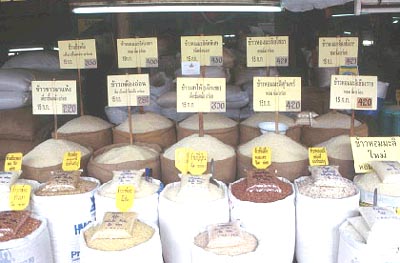
A5.9.5 Resources, Facilities, Equipment and Material
Required During Workshops
|
Human resources:
- interpreting facilities (if required);
- two rapporteurs;
- secretaries/typists with excellent knowledge of Microsoft Office
package.
Logistics:
- adequate meeting room;
- sound amplification system (depending on size of meeting room, its
acoustics and number of participants);
- air conditioning (if required);
Equipment and instruments:
- two PCs(*) and a laser printer with new ink cartridge;
- photocopying facilities with adequate supply of paper;
- slide projector, overhead projector and large screen;
- one PC connected to a data projector (for presentations);
- flipcharts with adequate supply of paper sheets and felt pens (three
colours).
For individual participants:
- paper and pencils;
- technical documentation;
- coffeebreaks (depending duration of workshop);
- lunches (depending on local customs and duration of workshop).
For work groups:
- flip chart paper and stands with adequate supply of paper;
- felt pens (three colours) for large writing on flipchart sheets.
(*) Each PC should have:
- Windows 95 or above;
- minimum of 64 Mb RAM;
- Microsoft Office package;
- Internet access;
- Adobe Acrobat Reader (freely downloaded from: http://www.fao.org/pdf/acro-e.htm)
|
A5.10 Workshop agenda and report
format (phase 1 and 2)
A5.10.1 Pre-Case Study
|
WORKSHOP
"Food Supply and Distribution to (name of
city)" AGENDA Overview of present and future situations
(urban food security, FSDS structure and functioning,
etc.) FSDS constraints and solutions
Plenary discussions Issues for in-depth analysis
Plenary discussions Workshop conclusions and recommendations Workshop final statement
|
A5.10.2 Case Study, Policy and Programmes
|
WORKSHOP
"FSD Policies, Strategies and Programmes for (name of
city)" AGENDA Overview of present and future situations
(urban food security, FSDS structure and functioning),
etc. FSDS constraints and solutions
Plenary discussions Summary of results of specific in-depth analysis
Plenary discussions Urban FSD policy and strategies
Plenary discussions FSD development programmes and subprogrammes
Plenary discussions Workshop conclusions and recommendations Workshop final statement
|
A5.10.3 Workshop Report Format (Phase 1)
- Executive summary;
- Introduction;
- Workshop final statement;
- Brief overview of present and future situation;
- Summary of diagnosis and selected solutions (revised following workshop
discussions);
- Issues for in-depth analysis (revised following workshop discussions).
Annexes:
- Agenda of the workshop;
- Summary of speeches;
- Maps, drawings and statistical data;
- Subjects for interinstitutional collaboration;
- Forms of collaboration with local institutions;
- Resources which will be made available to the team by different local
institutions;
- List of participants.
|
A5.10.4 Workshop Report Format (Phase 2)
- Executive summary;
- Introduction;
- Workshop final statement;
- Brief overview of present and future situation;
- FSDS constraints and solutions;
- Summary of results of in-depth analysis (revised following workshop
discussions);
- Urban food supply and distribution policy and strategies (revised
following workshop discussions);
- FSD development programmes and subprogrammes (revised following workshop
discussions).
Annexes:
- Agenda of the workshop;
- Summary of speeches;
- Maps, drawings and statistical data;
- List of participants.
|









